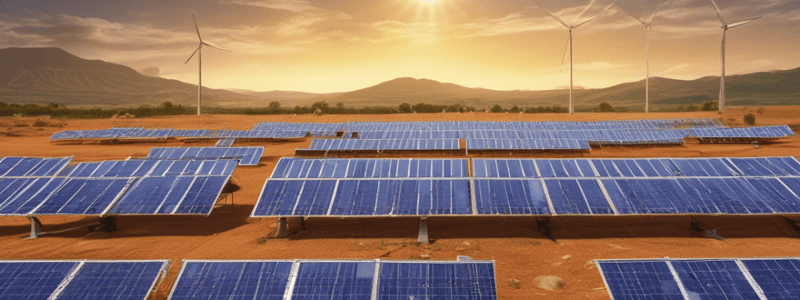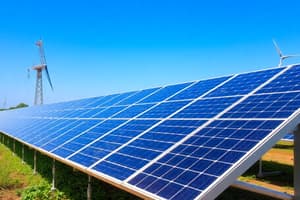Podcast
Questions and Answers
What is the principle behind solar power?
What is the principle behind solar power?
- Producing electricity directly from sunlight (correct)
- Using sunlight to heat water
- Generating electricity from nuclear reactions
- Converting sunlight directly into mechanical energy
What happens when photons strike a PV cell?
What happens when photons strike a PV cell?
- They are always passed through
- They may be reflected, absorbed or can pass through the p-n junction (correct)
- They are always absorbed
- They are always reflected
What is the purpose of the n-type material in a solar cell?
What is the purpose of the n-type material in a solar cell?
- To absorb sunlight
- To block sunlight
- To allow light to pass through and strike the p-n junction (correct)
- To reflect sunlight
What is the depletion zone in a p-n junction?
What is the depletion zone in a p-n junction?
What is the function of a wire connected from the cathode to an anode in a solar cell?
What is the function of a wire connected from the cathode to an anode in a solar cell?
What is the purpose of a storage battery in a stand-alone power system?
What is the purpose of a storage battery in a stand-alone power system?
What is a stand-alone power system?
What is a stand-alone power system?
What is the function of an inverter in a solar PV system?
What is the function of an inverter in a solar PV system?
What is the main purpose of a power conditioner in a photovoltaic system?
What is the main purpose of a power conditioner in a photovoltaic system?
What is the primary advantage of fuel cells over batteries?
What is the primary advantage of fuel cells over batteries?
What is the chief advantage of fuel cells over traditional power generation methods?
What is the chief advantage of fuel cells over traditional power generation methods?
What is the primary component of a fuel cell that facilitates the transfer of electrons?
What is the primary component of a fuel cell that facilitates the transfer of electrons?
What is the classification of fuel cells based on the type of fuel and oxidant used?
What is the classification of fuel cells based on the type of fuel and oxidant used?
What is the primary application of fuel cells?
What is the primary application of fuel cells?
What is the advantage of fuel cells in terms of pollution?
What is the advantage of fuel cells in terms of pollution?
What is the primary disadvantage of fuel cells?
What is the primary disadvantage of fuel cells?
What is the primary method of generating electrical power in a photovoltaic system?
What is the primary method of generating electrical power in a photovoltaic system?
What is the material used to make solar cells?
What is the material used to make solar cells?
What has driven the decrease in cost of solar cells?
What has driven the decrease in cost of solar cells?
What is the current competitiveness of solar photovoltaic power generation with conventional methods?
What is the current competitiveness of solar photovoltaic power generation with conventional methods?
How many countries use solar photovoltaic technology?
How many countries use solar photovoltaic technology?
What is the total capacity of solar photovoltaic power generation installed worldwide?
What is the total capacity of solar photovoltaic power generation installed worldwide?
What is the photovoltaic effect?
What is the photovoltaic effect?
What happens when light strikes crystals such as silicon or germanium?
What happens when light strikes crystals such as silicon or germanium?
What type of fuel cell is described as the most efficient and highly developed?
What type of fuel cell is described as the most efficient and highly developed?
What is the function of the electrolyte in a fuel cell?
What is the function of the electrolyte in a fuel cell?
What is the output voltage of a Phosphoric acid or hydrogen-oxygen fuel cell?
What is the output voltage of a Phosphoric acid or hydrogen-oxygen fuel cell?
What is the source of geothermal energy?
What is the source of geothermal energy?
What is the temperature of the Earth's core?
What is the temperature of the Earth's core?
What is the purpose of fracturing the hot dry rock in a hot dry rock geothermal system?
What is the purpose of fracturing the hot dry rock in a hot dry rock geothermal system?
What type of fuel cell uses a proton conducting polymer membrane as the electrolyte?
What type of fuel cell uses a proton conducting polymer membrane as the electrolyte?
What is the name of the molten rock within the Earth?
What is the name of the molten rock within the Earth?
What is the approximate temperature of the rock at a depth of 5 km?
What is the approximate temperature of the rock at a depth of 5 km?
What is the minimum pressure required for water to boil underground in a hydrothermal resource?
What is the minimum pressure required for water to boil underground in a hydrothermal resource?
What is the purpose of a centrifuge separator in a vapour dominated plant?
What is the purpose of a centrifuge separator in a vapour dominated plant?
What is the cycle used in a vapour dominated plant?
What is the cycle used in a vapour dominated plant?
What is the minimum temperature required for a liquid dominated high-temperature plant?
What is the minimum temperature required for a liquid dominated high-temperature plant?
What is the purpose of a flash evaporator in a liquid dominated high-temperature plant?
What is the purpose of a flash evaporator in a liquid dominated high-temperature plant?
What is the working medium used in a liquid dominated low-temperature plant?
What is the working medium used in a liquid dominated low-temperature plant?
What is the advantage of the total flow concept system?
What is the advantage of the total flow concept system?
Flashcards are hidden until you start studying
Study Notes
Direct Energy Conversion
- Photovoltaic (PV) system: generates electrical power by converting solar radiation into direct electricity using semiconductors that exhibit the photovoltaic effect.
Photovoltaic Effect
- Process where two dissimilar materials in close contact produce an electrical charge when struck by light or radiant energy.
- In a p-n junction, electrons are not free to move from n-region to p-region due to the potential barrier.
- Light provides the energy needed to free some electrons, creating a negative voltage with respect to the other side.
- The photovoltaic effect can continue to provide voltage and current as long as light falls on the junction.
Solar Power
- Production of electricity directly from sunlight.
- PV power is produced using the photovoltaic effect, releasing electrons from the p-n junction and pushing them across a potential barrier or electric field.
- Sunlight is composed of energy packets called photons, which may be reflected, absorbed, or pass through the p-n junction.
- Absorbed photons generate electricity, and the light travels in packets of energy called photons.
Stand-alone Solar PV System
- Designed to meet any electrical load.
- Principal components:
- Photovoltaic array (PV) consisting of interconnected modules.
- Storage battery (supplies energy during periods of low solar irradiance and stores energy during periods of high irradiance).
- Power conditioner (regulates voltage output of the PV array to prevent overcharging or discharge).
Fuel Cells
- Electrochemical device that converts the chemical energy of a fuel directly into low-voltage, direct current electrical energy.
- Advantages:
- High conversion efficiencies.
- Low maintenance.
- Can be installed near the use point.
- Odorless and noiseless.
- Fast response time.
- Space requirement is minimal.
- Simple and safe.
- Pollution-free.
- No cooling water required.
- Capacity can be increased as demand grows.
- Long life.
- Disadvantages:
- High initial cost.
- Low service life.
- Refueling problems in vehicles.
- Applications:
- Domestic use.
- Automotive vehicles.
- Central power stations.
- Defense applications.
- Space projects.
Components and Working Theory of a Fuel Cell
- Components:
- Anode (fuel electrode).
- Cathode (oxidant electrode).
- Electrolyte.
- Container.
- Separators.
- Fuel supply.
- Working theory:
- Fuel gas diffuses through the anode and is oxidized, releasing electrons to the external circuit.
- Oxidizer diffuses through the cathode and is reduced by the electrons.
- Fuel cell keeps the fuel molecules from mixing with the oxidizer molecules, allowing the transfer of electrons by a metallic path.
Classification of Fuel Cells
- Based on the type of electrolyte:
- Alkaline fuel cell (AFC).
- Phosphoric acid fuel cell (PAFC).
- Polymer electrolyte membrane fuel cell (PEMFC).
- Molten carbonate fuel cell (MCFC).
- Solid oxide fuel cell (SOFC).
- Based on operating temperature:
- Low temperature fuel cell (25-100°C).
- Medium temperature fuel cell (below 100-500°C).
- High temperature fuel cell (500-1000°C).
- Very high temperature fuel cell (Above 1100°C).
- Based on the types of fuel and oxidant:
- Hydrogen-oxygen fuel cell.
- Hydrogen-air fuel cell.
- Hydrazine-oxygen fuel cell.
- Ammonia-air fuel cell.
- Synthesis gas-air fuel cell.
- Hydrocarbon (gas) - air fuel cell.
- Hydrocarbon (liquid) - air fuel cell.
Types of Fuel Cells
- Hydrogen-Oxygen Fuel Cell:
- A cell that generates an electric current by converting the chemical energy of a fuel directly into electrical energy.
- Fuel in a suitable form is supplied to the negative electrode and oxygen to the positive electrode.
- Phosphoric Acid or Hydrogen-Oxygen Fuel Cell:
- Fuel: hydrogen.
- Oxidant: oxygen.
- Electrolyte: phosphoric acid.
- Electrodes: porous nickel.
- Output: 1.23 V at 25%.
- Efficiency: 85%.
- Alkaline Fuel Cell:
- Fuel: hydrogen or hydrogen-rich gas.
- Oxidant: oxygen or air.
- Electrodes: porous nickel.
- Electrolyte: KOH (40%).
- Output: 1.23 V at 90°C.
- Polymer Electrolyte or Proton Exchange Membrane Fuel Cell:
- Fuel: hydrogen.
- Oxidant: oxygen.
- Electrodes: deposited platinum layers.
- Electrolyte: proton-conducting polymer membrane.
- Output: 1.23 V at 25°C.
Geothermal Energy
- Thermal energy present in the interior of the earth.
- Can be extracted from the earth's interior in the form of heat.
- Volcanoes, geysers, and hot springs are visible signs of the large amounts of heat lying in the earth's interior.
- The geothermal energy from the earth's interior is almost inexhaustible.
- Useful geothermal energy can be extracted at only certain suitable sites.
Hot Dry Rock Geothermal System
- Composed of hot dry rock (HDR) but no underground water.
- Represent the largest geothermal resources available.
- Recovery of heat from HDR involves drilling deep into hot rocks, then cracking it to form a cavity or fractures.
Vapor-Dominated Plant
- Water boils underground in a hydrothermal resource when it has a pressure of about 7 atm and a temperature of about 165°C.
- The plant consists of:
- Production well to extract steam from the hydrothermal resource.
- Centrifuge separator to remove solid matter from the steam.
- Turbine to convert thermal energy into mechanical energy.
- Generator coupled to the turbine to generate electric power.
- Condenser to condense wet steam exited from the turbine into water.
- Cooling tower to cool warm water exited from the condenser.
Wet Steam or Liquid-Dominated Plant
- Can be divided into high-temperature (above 175°C) and low-temperature (range of 95-175°C) systems.
- High-temperature plant:
- Flash evaporator to obtain dry steam from high-temperature wet steam.
- Turbine with directly coupled generator to extract energy from dry steam.
- Condenser to condense used steam into water.
- Cooling tower to cool warm water.
- Low-temperature plant:
- Uses a low-boiling-point refrigerant as the working medium.
- The plant runs on a binary cycle.
- The refrigerant is evaporated in a heat exchanger using the heat of water obtained from the hydrothermal reservoir.
- The refrigerant vapor runs the turbine with a generator coupled to it.
Total Flow Concept of Geothermal Energy
- Utilizes both the kinetic energy and heat energy of the steam-liquid mixture produced by flashing the geothermal brine.
- The overall efficiency for conversion into electrical energy should be greater than other methods.
- This system utilizes the principle of the Lysholm machine, known as the helical (or screw) expander or mixed-phase expander.
- Requirements of mixed-phase expanders:
- They should be able to overcome the losses associated with the impingement of liquid droplets on blades.
- They must be able to withstand the corrosive and erosive effects.
Studying That Suits You
Use AI to generate personalized quizzes and flashcards to suit your learning preferences.





